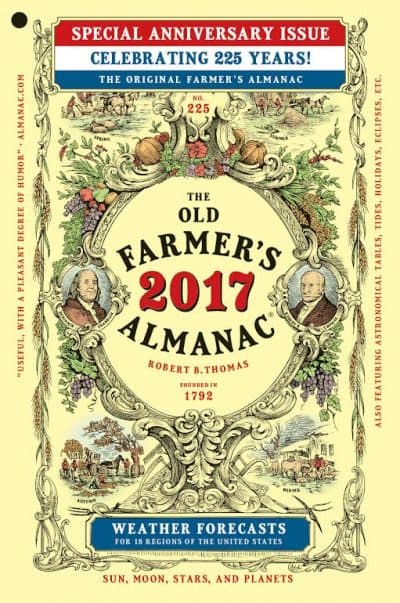Advertisement
Old Farmer's Almanac Celebrates 225 Years Of Publication

The Old Farmer's Almanac is the longest continually published periodical in American history. It turns 225 years old with the 2017 edition, which is on newsstands now.
It's filled with the usual blend of advice, recipes and nuggets of knowledge that readers have come to expect over the years.
Here & Now's Jeremy Hobson speaks with Janice Stillman, the almanac's editor, about the milestone.
Interview Highlights: Janice Stillman
On farmer's almanacs in general
"There have always been farmer's almanacs. It's a genre like sports and news and fashion and whatever. And folks have used farmer's almanacs for as long as they've been gardening and raising animals. But the Old Farmer's Almanac is a true calendar of the heavens, which means you have the predictions for all of the astronomical events for every day throughout the year, and from the calendar flows all the rest of the content: the weather, certainly; the gardening, because, there you go, you get the seasons. Then you get recipes to do things with what you grow from. You've got folklore, which so much applies often to what you grow — herbs as well as vegetables and different fruits and things. And it just goes on from there, but that's the heart and soul of the Old Farmer's Almanac."
On predictions for winter
"It's going to be a relatively mild winter in most of the country. In fact, through the whole central part of the country it's going to be mild and dry. Some snow where you usually get snow, but about normal temperatures, below normal precipitation. The West Coast will be cold and dry for the most part. That's California, where they need the water most. The snow and moisture is going to fall up in the Northwest, and then mostly all across the border along Canada is where you're going to see the coldest temperatures and the snow. And there will be some snow down through the Appalachians as well, but that's really about it. You know, snow where you expect snow, but a lot than you're used to."
On the total solar eclipse prediction for 2017
"Make plans now: that's August 21, next summer. It's a Monday, so take a long weekend. You have to travel a little bit to get down in the best part of it, but you want to position yourself in the path of the eclipse. It's going to be from Oregon, around Portland, to around Columbia, South Carolina. And it's the weird the effects that happens in the path of the eclipse, like the shadows that are created, the eclipse wind that occurs in the moment before and the moment after it happens. So I've talked to some towns along the line across the country, in the Midwest, for example, and they said they're already planning events for anybody who comes to their towns — this was in Missouri. But there's 101 and more places you could go to to be in the path of it. It's really a once-in-a-lifetime event."
On the almanac's weather forecast prediction methods
"We use three scientific disciplines. We use solar science, which is the study of the activity on the sun — in particular the sun spots, but there's other solar activity. We use climatology, which means that we look back in time to see how the solar activity corresponds to the climate and weather here on Earth. And then we use meteorology, which is the water temperature, the ocean that is, the ocean temperatures, the land temperatures, the jet stream and things like that. But I should tell you that anybody who knows anything about sun spots — now we didn't invent this and we're not the only ones who follow this science. Solar science is very common. This is, we're currently in one of the lowest cycles in more than 100 years, and historically, when that has happened in the past, there have been many years of well-below-normal cold temperatures. Look it up. We're not saying that that's absolutely going to happen. Currently we're thinking that the cold influence of the sun may be mitigated for a while by greenhouse gases. But, a few years from now, maybe even a few decades, something could happen."
Advertisement
On how the almanac's changed over the years
"The content has changed. There are more pages, there were 46 pages in the first edition. There are color pages now, many more of those. There are many more articles. You know, we like to think — certainly it's national. When it first started, it was just a regional, New England publication — but we like to think that it is really the same publication, but suited to everybody out there. And, of course, Robert B. Thomas, back in 1792, did not have the internet and e-reading devices we have today. For virtually anything that you use, you can get an Old Farmer's Almanac."
Guest
Janice Stillman, editor of the Old Farmer's Almanac. The publication tweets @almanac.
This article was originally published on September 19, 2016.
This segment aired on September 19, 2016.